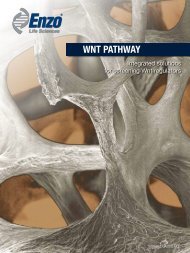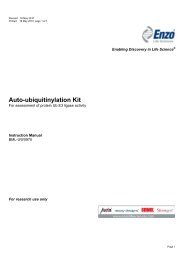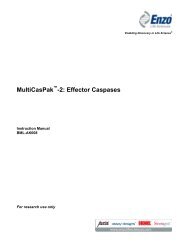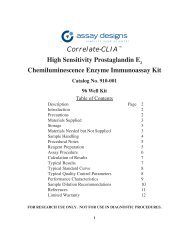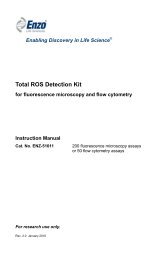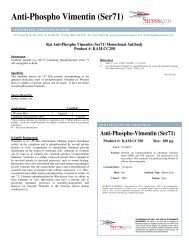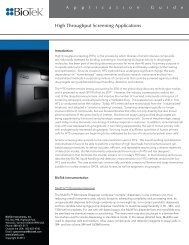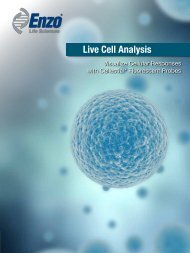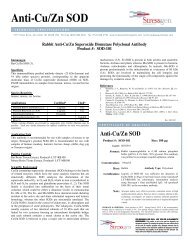You also want an ePaper? Increase the reach of your titles
YUMPU automatically turns print PDFs into web optimized ePapers that Google loves.
ControlsA sample of untreated cells should always be processed to control for endogenous levelsof damage within cells, and for damage that may occur during sample preparation.Control cells and treated cells should be handled in an identical manner. If UV damageis being studied, the cells should be kept in low level yellow light during processing.If you require a sample that will be positive for comet tails, treat cells with 100 μMhydrogen peroxide or 25 μM KMnO 4for 20 minutes at 4˚C.Treatment will generate significant oxidative damage in the majority of cells, therebyproviding a positive control for each step in the comet assay. Note that the dimensionsand characteristics of the comet tail, as a consequence of H 2O 2or KMnO 4treatment,may be different to those induced by the damage under investigation.Method for Cryopreservation of Cells Prior to use in the <strong>COMET</strong> <strong>SCGE</strong> <strong>Assay</strong>Certain cells, e.g., lymphocytes, may be successfully cryopreserved prior to performingthe <strong>COMET</strong> <strong>SCGE</strong> <strong>Assay</strong> (Visvardis, et al.). A pilot study should be performed todetermine if cryopreservation is appropriate for the cells in use.1. Centrifuge cells at 200 x g for 5 minutes.2. Resuspend cell pellet at 1 x 10 7 cells/mL in 10% (v/v) dimethylsulfoxide,40% (v/v) medium, 50% (v/v) fetal calf serum.3. Transfer aliquots of 2 x 10 6 cells into freezing vials.4. Freeze at -70˚C with -1˚C per minute freezing rate.5. Recover cells by submerging in 37˚C water bath until the last trace of ice hasmelted.6. Transfer to 15 mL of prechilled 40% (v/v) medium, 10% (w/v) dextrose, 50%(v/v) fetal calf serum.7. Centrifuge at 200 x g for 10 minutes at 4˚C.8. Resuspend in ice cold 1X PBS (Ca 2+ and Mg 2+ free) and proceed with the<strong>COMET</strong> <strong>SCGE</strong> <strong>Assay</strong>.<strong>Assay</strong> Designs734.668.6113 or 800.833.8651www.assaydesigns.com
<strong>Assay</strong> ProcedureBoth protocols provided are for alkali unwinding conditions. The electrophoresisconditions will determine the sensitivity of the assay. TBE electrophoresis or Neutralelectrophoresis after alkali unwinding will detect single-stranded DNA breaks,double-stranded DNA breaks, and may detect a few apurinic sites, apyrimidinicsites. Alkaline electrophoresis will detect single-stranded DNA breaks, doublestrandedDNA breaks, and the majority of apurinic sites, apyrimidinic sites as wellas alkali labile DNA adducts (e.g. phosphoglycols, phosphotriesters). The <strong>COMET</strong><strong>SCGE</strong> <strong>Assay</strong> has been reported to detect DNA damage associated with low doses(0.6 cGy) of gamma irradiation, providing a simple technique for quantitation oflow levels of DNA damage. Prior to performing the <strong>COMET</strong> <strong>SCGE</strong> <strong>Assay</strong>, a viabilityassay should be performed to determine the dose of the test substance that gives atleast 75% viability. False positives may occur when high doses of cytotoxic agentsare used. For information on performing the neutral comet assay that will predominantlydetect double-stranded DNA breaks, see Appendix A. For cryopreservation ofcells, fixing the Comet Slide samples, and storage, refer to Sample Handling.The <strong>COMET</strong> <strong>SCGE</strong> <strong>Assay</strong> requires approximately 2-3 hours to complete, includingthe incubations and electrophoresis. Once the cells or tissues have been prepared,the procedure is not labor intensive. The Lysis Solution may be chilled and theLMAgarose melted while the cell and tissue samples are being prepared.All steps are performed at room temperature unless otherwise specified.Work under dimmed or yellow light to prevent damage from UV.1. Prepare Lysis Solution and chill at 4˚C or on ice for at least 20 minutesbefore use.2. Melt LMAgarose in a beaker of boiling water for 5 minutes, with the caploosened. Place bottle in a 37˚C water bath for at least 20 minutes tocool. The temperature of the agarose is critical or the cells may undergoheat shock. Heat blocks are not recommended for regulating the temperatureof the agarose.3. Combine cells at 1 x 10 5 /mL with molten LMAgarose (at 37˚C) at a ratioof 1:10 (v/v) and immediately pipette 75 μL onto the Comet Slide. If necessary,use side of pipette tip to spread agarose/cells over sample area toensure complete coverage of the sample area. When working with manysamples it may be convenient to place aliquots of the molten agaroseinto prewarmed microcentrifuge tubes and place the tubes at 37˚C. Addcells to one tube, mix by gently pipetting once or twice, then transfer 75μL aliquots onto each sample area as required. Then proceed with thenext sample of cells.Comet LMAgarose (molten and at 37˚C from step 2)Cells in 1X PBS (Ca 2+ and Mg 2+ free) at 1 x 10 5 /mL500 μL50 μLNote: If sample is not spreading evenly on the slide, warm the slide at 37˚Cbefore application.<strong>Assay</strong> Designs734.668.6113 or 800.833.8651www.assaydesigns.com
4. Place slide flat at 4˚C in the dark (e.g. place in refrigerator) for 10 minutes. A0.5 mm clear ring appears at edge of the Comet Slide area. Increasing gellingtime to 30 minutes improves adherence of samples in high humidity environments.5. Immerse slide in prechilled Lysis Solution and leave on ice, or at 4˚C, for 30 to 60minutes.6. Tap off excess buffer from slide and immerse in freshly prepared AlkalineSolution, pH>13 (see Reagent Preparation). WEAR GLOVES WHEN PREPARINGOR HANDLING THIS SOLUTION.7. Leave the Comet Slide in Alkaline Solution for 20 to 60 minutes at roomtemperature, in the dark.To perform TBE Electrophoresis go to step 8 or for Alkaline go to step 13.8. Remove slide from Alkaline Solution, gently tap excess buffer from slide andwash by immersing in 1X TBE buffer for 5 minutes, 2 times (see ReagentPreparation).9. Transfer slide from 1X TBE buffer to an horizontal electrophoresis apparatus.Place slides flat onto a gel tray and align equidistant from the electrodes. Pour1X TBE buffer until level just covers samples. Set power supply to 1 volt per cm(measured electrode to electrode). Apply voltage for 10 minutes.10. Very gently tap off excess TBE, and dip slide in 70% ethanol for 5 minutes.11. Air dry samples. Drying brings all the cells in a single plane to facilitateobservation. At this stage, samples may be stored at room temperature, withdesiccant.NOTE: Silver staining allows visualization of comets on any transmission lightmicroscope and permanently stains the samples for archiving and long termstorage. It is recommended that samples be dried before silver staining.12. Proceed to Step 16.For Alkaline Electrophoresis13. Transfer slide from Alkaline Solution to a horizontal electrophoresis apparatus.Place slides flat onto a gel tray and align equidistant from the electrodes.Carefully pour the Alkaline Solution until level just covers samples. Set the voltageto about 1 volt/cm. Add or remove buffer until the current is approximately 300mA and perform electrophoresis for 20-40 minutes.<strong>Assay</strong> Designs734.668.6113 or 800.833.8651www.assaydesigns.com
Tips:Since the Alkaline Electrophoresis Solution is a non-buffered system,temperature control is highly recommended. In-house testing has shown greattemperature fluctuations when conducting the alkaline electrophoresis at ambienttemperature. To improve temperature control, the use of a large electrophoresis apparatus(25-30 cm between electrodes) is recommended along with recirculation ofthe electrophoresis solution. Alternatively, performing the electrophoresis at coolertemperatures (e.g. 16˚C or 4˚C) will diminish background damage, increase sampleadherence at high pHs and significantly improves reproducibility. Choose the methodthat is most convenient for your laboratory and always use the same conditions,power supplies and electrophoresis chambers for comparative analysis.14. Gently tap off excess electrophoresis solution, rinse by dipping several times indeionized water, then immerse slide in 70% ethanol for 5 minutes.15. Air dry samples. Drying brings all the cells in a single plane to facilitate observation.Samples may be stored at room temperature, with desiccant prior toscoring at this stage.NOTE: Silver staining allows visualization of comets on any transmission lightmicroscope and permanently stains the samples for archiving and long termstorage. It is recommended that samples be dried before silver staining.16. Place 50 μL of diluted SYBR ® Green1 (see Reagent Preparation onto each circleof dried agarose.17. View slide by epifluorescence microscopy. (SYBR ® Green I’s maximum excitationand emission are respectively 494nm/521nm. Fluorescein filter is adequate).<strong>Assay</strong> Designs734.668.6113 or 800.833.8651www.assaydesigns.com10
Data AnalysisWhen excited (425-500 nm) the DNA-bound SYBR ® Green I emits green light. In healthycells the fluorescence is confined to the nucleoid: undamaged DNA is supercoiledand thus does not migrate very far of the nucleoid under the influence of an electriccurrent. In cells that have accrued damage to the DNA, the alkali treatment unwindsthe DNA, releasing fragments that migrate from the cell when subjected to an electricfield. The negatively charged DNA migrates toward the anode and the extrusionlength reflects increasing relaxation of supercoiling, which is indicative of damage.When using TBE as the electrophoresis buffer, the length of the comet tail may becorrelated with DNA damage. When using alkaline electrophoresis conditions, thedistribution of DNA between the tail and the head of the comet should be used toevaluate the degree of DNA damage. The characteristics of the comet tail includinglength, width, and DNA content may also be useful in assessing qualitative differencesin the type of DNA damage.Qualitative AnalysisThe comet tail can be scored according to DNA content (intensity). The control(untreated cells) should be used to determine the characteristics of data for a healthycell. Scoring can then be made according to nominal, medium or high intensity tailDNA content. At least 75 cells should be scored per sample.Quantitative AnalysisThere are several image analysis systems that are suitable for quantitation of<strong>COMET</strong> <strong>SCGE</strong> <strong>Assay</strong> data. The more sophisticated systems include the microscope,camera and computer analysis package. These systems can be set up to establish thelength of DNA migration, image length, nuclear size, and calculate the tail moment.At least 75 randomly selected cells should be analyzed per sample.11<strong>Assay</strong> Designs734.668.6113 or 800.833.8651www.assaydesigns.com
Appendix A : Neutral <strong>COMET</strong> <strong>SCGE</strong> <strong>Assay</strong>The <strong>COMET</strong> <strong>SCGE</strong> <strong>Assay</strong> may be performed using neutral conditions. Withouttreatment with Alkaline Buffer, the Neutral <strong>COMET</strong> <strong>SCGE</strong> <strong>Assay</strong> will detect mainlydouble-stranded breaks and can be useful for assessing the DNA fragmentationassociated with apoptosis.1. Prepare Lysis Solution (see Reagent Preparation) and chill at 4˚C or on ice forat least 20 minutes before use.2. Melt LMAgarose in a beaker of boiling water for 5 minutes, with the cap loosened,then cool in a 37˚C water bath for at least 20 minutes.3. Combine cells at 1 x 10 5 /mL with molten LMAgarose (at 37˚C) at a ratio of1:10 (v/v) and immediately pipette 75 μl onto a Comet Slide. Use side ofpipette tip to spread agarose/cells over sample area.Comet LMAgarose (molten and at 37˚C from step 2)Cells in 1X PBS (Ca 2+ and Mg 2+ free) at 1 x 10 5 /mL13500 μL50 μLNote: If sample is not spreading evenly on the slide, warm the slide at 37 ˚C beforeapplication.4. Place slides flat at 4˚C in the dark (e.g. place in refrigerator) for 10 minutes. A0.5 mm clear ring appears at edge of the Comet Slide area. Increasing gellingtime to 30 minutes improves adherence of samples in high humidity environments.5. Immerse slide in prechilled (Step 1) Lysis Solution and leave on ice or at 4˚C for30 minutes.6. Remove slide from Lysis Buffer, tap excess buffer from slide and wash slide byimmersing in 50 mL of 1X TBE buffer (see Reagent Preparation).7. Transfer slides from 1X TBE buffer, and place flat onto a gel tray submerged in1X TBE buffer in a horizontal electrophoresis apparatus. Align slides equidistantfrom the electrodes. Set power supply to 1 volt/cm (measured electrode toelectrode). Apply voltage for 10-20 minutes.8. Tap off excess TBE, rinse slides briefly in deionized water.9. Immerse slide in 70% ethanol for 5 minutes10. Air dry samples. Drying brings all the cells in a single plane to facilitate observation.Samples may be stored at room temperature, with desiccant prior toscoring at this stage.NOTE: Silver staining allows visualization of comets on any transmission lightmicroscope and permanently stains the samples for archiving and long termstorage. It is recommended that samples be dried before silver staining.11. Place 50 μL of diluted SYBR ® Green 1 onto each sample.12. View slide by epifluorescence microscopy using (Fluorescein filter is adequate).(SYBR ® Green I’s maximum excitation and emission are respectively 494nm/521nm.)<strong>Assay</strong> Designs734.668.6113 or 800.833.8651www.assaydesigns.com
Limited Warranty<strong>Assay</strong> Designs, Inc. warrants that at the time of shipment this product is free from defects in materialsand workmanship. This warranty is in lieu of any other warranty expressed or implied, including butnot limited to, any implied warranty of merchantability or fitness for a particular purpose.MSDS (MaterialSafety Data Sheet)available online<strong>Assay</strong> Designs must be notified of any breach of this warranty within 48 hours of receipt of theproduct. No claim shall be honored if <strong>Assay</strong> Designs is not notified within this time period, or if theproduct has been stored in any way other than outlined in this publication. The sole and exclusiveremedy of the customer for any liability based upon this warranty is limited to the replacement ofthe product, or refund of the invoice price of the goods.<strong>Assay</strong> Designs, Inc.5777 Hines DriveAnn Arbor, MichiganUSAtel: 734.668.6113 or 800.833.8651fax: 734.668.2793info@assaydesigns.comwww.assaydesigns.comtechnical support: technical@assaydesigns.comKits for Charity<strong>Assay</strong> Designs has always been an active contributor to a number of local,national and international charities. We have broadened our charitable contributionsby implementing a program called Kits for Charity.Each quarter, <strong>Assay</strong> Designs will feature a different non-religious and non-political charitableorganization on our website. For each kit sold during this time period, we will make a monetarycontribution to the featured charity. Please check our website for the current quarter’s charity tosee what organization your purchases are helping to support.If you have any suggestions for future Kits for Charity recipients, please contact us at800.833.8651 or 734.668.6113.Contact UsFor more details concerning the information within this kit insert, or to order any of the <strong>Assay</strong>Designs’ products, please call (734) 668-6113 between 8:30 a.m. and 5:30 p.m. EST. Orders ortechnical questions can also be transmitted by fax or e-mail 24 hours a day.CometSlide TM is a trademark of Trevigen, Inc.Catalog No. 25-0610 Last Revised: June 11, 2008© 2007<strong>Assay</strong> Designs734.668.6113 or 800.833.8651www.assaydesigns.com16



